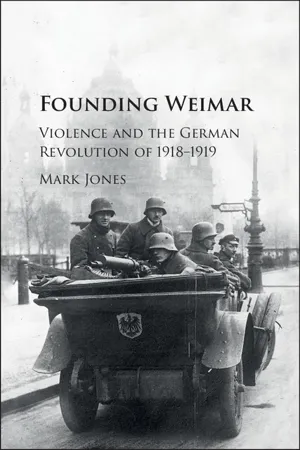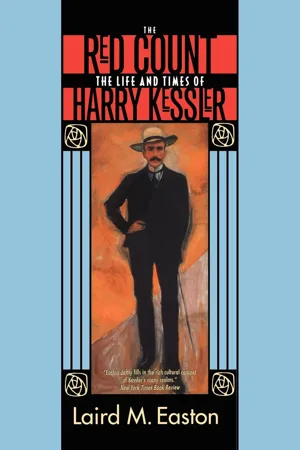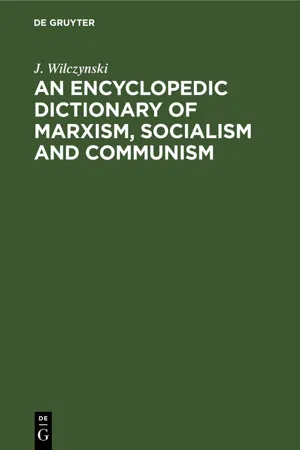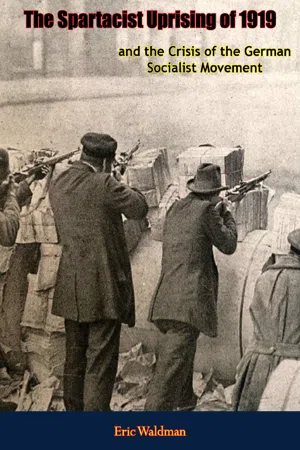History
Spartacist Uprising
The Spartacist Uprising was a major revolt in Germany in January 1919, led by the Spartacus League, a radical socialist group. The uprising aimed to overthrow the Weimar government and establish a communist state. The revolt was brutally suppressed by the government, leading to the deaths of many Spartacist leaders and supporters.
Written by Perlego with AI-assistance
Related key terms
1 of 5
4 Key excerpts on "Spartacist Uprising"
- eBook - PDF
Founding Weimar
Violence and the German Revolution of 1918–1919
- Mark Jones(Author)
- 2016(Publication Date)
- Cambridge University Press(Publisher)
To 1 Since the 1970s, German historians, led by Heinrich August Winkler, have drawn atten- tion to the problematic nature of the term ‘Spartacist Uprising’. They have rejected its usage precisely because it suggests that the Spartacist Group was in control of the Upris- ing. Historical research has shown beyond doubt that this was not the case. Moreover, the use of the term ‘Spartacist Uprising’ has been eschewed by many German historians because of its associations with Nazi myths of the revolution. On the leadership of the Uprising, see Winkler, Von der Revolution, 122–3; Winkler, Weimar 1918–1933, 58. 173 174 The January Uprising demonstrate the importance of how these themes interacted, this chapter begins with an examination of pro- and anti-government demonstrations on 5 and 6 January 1919, paying particular attention to the role and representation of political crowds. It retraces the rumours that came into existence alongside these crowds, and shows how the interaction of crowds and rumours mobilized both the government and its opponents, leading to a radicalization of discourses. This examination of the radi- calization of words is followed by a close examination of the escalation of violence: this is the first historical study to analyse media accounts of the opening exchanges of gunfire. As the chapter proceeds, it shows how, on both sides, accusations of enemy atrocities were a crucial part of the conflict’s evolution. By doing so, it reveals how the political contestation of the legitimacy of violence was central to the escalation of the crisis, and, most importantly, to the prevention of de-escalation. As it tackles these themes, the chapter engages in a close analysis of the political life of the streets – the way that micro-events in the streets of Berlin came to define the broader political meanings of the revolution – during the most significant challenge to the political order since November. - eBook - PDF
The Red Count
The Life and Times of Harry Kessler
- Laird M. Easton(Author)
- 2002(Publication Date)
- University of California Press(Publisher)
17 As the reluctance of the Majority Socialists to pursue a thorough re-structuring and democratization of German society became increasingly evident in December 1918, distrust and impatience with their leadership grew in the ranks of the council movement and among Independent So-cialists. The establishment of the Communist Party by Spartacists, con-cerned that the revolutionary opportunity was fading away, further po-larized the left. The first stage of the German revolution concluded therefore in the middle of January 1919 when rank-and-file anger com-pelled the leadership of the Spartacists, against their better judgment, to launch an ill-timed and poorly organized insurrection in Berlin. The provisional government, now dominated completely by Majority So-cialists, used the only means of coercion they had at their disposal, the Freikorps —in essence, private armies of former veterans commanded by right-wing officers—to crush the revolt. Rosa Luxembourg and Karl Liebknecht were murdered by the Freikorps in the white terror that fol-lowed. The “blood crime” had been committed and the German left would never recover. Kessler was an omnipresent and sharp-witted observer of nearly all of these events in Berlin. His diary for the winter of 1918 –1919 offers one of the most vivid descriptions of the German revolution available, cine-matic in its detail, framing, and movement. Far from huddling in his apartment, he crisscrossed central Berlin continually like a peripatetic modern-day analogue to Restif de la Bretonne, the insomniac witness to the French Revolution. Always moving toward the sound of gunfire, seeking shelter now and then, engaging Freikorps soldiers and Spartacus agitators in conversation, using his various bona fides to pass road-blocks, and visiting an extraordinary range of acquaintances, he cap-tured the chaos and confusion of street fighting in dozens of small de-tails, incidents, and confrontations, little dramas without denouements. - eBook - PDF
An Encyclopedic Dictionary of Marxism, Socialism and Communism
Economic, Philosophical, Political and Sociological Theories, Concepts, Institutions and Practices - Classical and Modern, East-West Relations Included
- J. Wilczynski(Author)
- 2019(Publication Date)
- De Gruyter(Publisher)
Although for centuries S. was villified first in Roman and then in other Western literature, Marxists have rehabilitated him since the middle of the 19th c. and have idealized him as the first revolutionary leader. In Germany, in 1916, revolutionary Marxists formed the SPARTACUS LEAGUE, t h e f o r e r u n n e r of the German Communist Party. Spartacus League A revolutionary Marx-ist organization formed in Jan. 1916 with-in t h e SOCIAL-DEMOCRATIC PARTY OF GERMANY . It stemmed from the SPAR-TACUS LEAGUE INTERNATIONAL c r e a t e d in the preceding year and included K. LIEBKNECHT, ROSA LUXEMBURG, F. MEHR-ING a n d CLARA ZETKIN . T h e L e a g u e w a s named after SPARTACUS , a militant slave leader in ancient Rome. The League pub-lished a radical bulletin called Spartacus Letters, edited by K. Liebknecht. The League was strongly opposed to the war and its leaders were imprisoned by the German authorities. In 1917, the S.L. joined the Independent Social-Democratic Party of Germany and later sought alliance with the victorious Bol-sheviks. The League became the nucleus f o r t h e GERMAN COMMUNIST PARTY (founded on 1 Jan. 1919). There is also a S.L. in the USA today, a student wing of t h e INTERNATIONAL MARXIST GROUP af-filiated t o t h e FOURTH INTERNATIONAL. Spartacus League International A left-wing group of German social-democrats in existence from March to Dec. 1915. It organized anti-war demonstrations and propaganda and published a bulletin under the same name, to which its leaders, incl. K. LIEBKNECHT a n d ROSA LUXEM-BURG, contributed. From Jan. 1916, it adopted the name of the SPARTACUS LEAGUE which became the nucleus of the German Communist Party. Special China List A version of the West-e r n STRATEGIC EMBARGO i n t r o d u c e d in 1952 in application to the PR of China, the DPR of [North] Korea and later ex-tended to the DR of [North] Vietnam. The S.Ch.L. was a much stricter form of export control than that applied to the European Socialist countries. - eBook - ePub
The Spartacist Uprising of 1919
and the Crisis of the German Socialist Movement
- Eric Waldman(Author)
- 2020(Publication Date)
- Barakaldo Books(Publisher)
Part 3—The Spartacists and the January Uprising
Chapter 5—“The Spartacists and the January Uprising”—Civil War in Berlin
1. The Test of Strength
The hostile encounters between the Majority Socialists and the left opposition during December 1918 had deepened the cleavage within the German socialist movement. Mutual animosity had grown in intensity. The rival demonstrations on December 29, 1918, at the occasion of the funeral for the victims of the Christmas incident, had illustrated the great antagonism existing between the “government” socialists and their opposition on the left. The attitude of the SPD leadership toward the left wing radicals was expressed in a candid article in Vorwaerts :The despicable actions of Liebknecht and Rosa Luxemburg soil the revolution and endanger all of its achievements. The masses must not sit by quietly for one minute longer while these brutal beasts and their followers paralyze the activities of the republican governmental offices, incite the people more and more to a civil war, and strangle with their dirty fists the right of free expression.They want to demolish and destroy with lies, slander, and violence everything which dares oppose them. They pose with boundless insolence as the masters of Berlin, in spite of the fact that at least nine-tenths of the population hate and despise their actions from the bottom of their souls....{351}Middle class circles joined the Majority Socialists in their attacks against the left wing radicals. At the end of December 1918, the so-called “Berlin Citizens’ Council” distributed a leaflet which, in the manner of the SPD, blamed primarily the Spartacists for the unrest and violence.Workers, Soldiers! The Christmas blows of the Spartacist group lead directly into the abyss. None of us wishes to spill blood. However, it is easier to cure a mad dog with biblical phrases than [to change] the Spartacists with gentle persuasion. The brutal force of these criminals can be countered only with force. If they intend to strike us down, we shall defend our skins. The hypocritical outcry of the Spartacists about the “blood bath” does not divert us from their intention to pit workers against workers and soldiers against soldiers.
Index pages curate the most relevant extracts from our library of academic textbooks. They’ve been created using an in-house natural language model (NLM), each adding context and meaning to key research topics.



